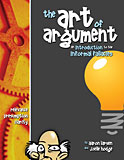By now, y’all know I love logic. Whether the more mathematical side of logic puzzlers or the more formal side of logical thinking, I’m on board (and so are my kids!) And I’m on a mission to get your family excited about this important subject.
This time around, I’m reviewing Art of the Argument: An Introduction to the Informal Fallacies by Aaron Lawson and Joelle Hodge.
 Written for middle school students, I’ve found it to be appropriate for many high school aged students as well. (Especially considering my 9th grader is the child currently using it.) In approximately 50 lessons, your child will cover 28 fallacies of irrelevance, presumption and clarity.
Written for middle school students, I’ve found it to be appropriate for many high school aged students as well. (Especially considering my 9th grader is the child currently using it.) In approximately 50 lessons, your child will cover 28 fallacies of irrelevance, presumption and clarity.
An informal fallacy is when an argument does not support itself. (Not an angry argument, mind you, but any time someone takes a position in a conversation.) For example, I might say, “My dog sheds like crazy in the spring, so all dogs must do the same.” I have committed the fallacy of generalization – taking my experience with one dog and transferring it to the entire population of dogs.
Everywhere you look, you can find informal fallacies – commercials, newscasts, political campaigns, and even in churches. When we aren’t aware of fallacies or don’t take the time to evaluate whether statements are well supported, we set ourselves up to believe whatever we hear. In today’s world, we simply cannot allow our children to grow up without the knowledge and encouragement to think clearly, lest they be pulled farther and farther away from the only real Truth that exists.
Now that I’ve gotten all serious on you, I’ll tell you that the program is far from serious and stuffy. Your children will have fun learning how to argue correctly and recognize fallacies. A series of dialogues between Socrates and two college students is sprinkled throughout the book and are both humorous and enlightening. Lessons are clear and concise with several illustrated examples to drive home the meaning of each fallacy. Socrates often comes in at the end of a lesson, too, to challenge your child to think about real-life fallacies and/or complete brief assignments.
Although the lessons are brief (15-20 minutes most days), your child will still get lots of experience recognizing fallacies, rewriting fallacies, noting definitions and answering short essay questions. At the end of each chapter, there is a review; and at the end of each unit, there is a cumulative review. A glossary at the end of the book as well as charts on the inside of the covers serve as reminders of each fallacy and its definition.
The Teacher’s Guide is exactly like the Student Workbook, except it includes all the answers AND supplies you with tests for each chapter and unit, with a final exam, too.
You’ll notice my review of The Fallacy Detective and The Thinking Toolbox by the Bluedorn’s below. Both are written for the same age level and concentrate on informal fallacies. How do they compare? Both cover similar material, with the Bluedorn’s possibly covering a tad more. However, the Bluedorn books are far more casual. While they include lots of oral questions, there is not much writing involved and no reviews or quizzes. I think both are extremely valuable in the middle/high school years! I recommend starting with The Fallacy Detective and The Thinking Toolbox (in that order), reading them together with your child and answering the oral questions together. Then, move into The Art of the Argument, allowing your child to take the reigns without as much direct involvement by you. (If anyone else has an opinion on this, please comment!)
We LOVE our time exploring logic and hope you do, too!
Find my other logic reviews:
The Fallacy Detective and The Thinking Toolbox
Prufrock Press Logic Resources
-Written by Cindy, an eclectically Charlotte Mason mom of three (high school, middle school, K4) in Central KY. You can find her blogging at Our Journey Westward and find her NaturExplorers series and other creative curricula at Shining Dawn Books.
(Cindy received a copy of Art of the Argument free in exchange for her honest opinion.)

Leave a Reply